cooling PONTIAC PONTIAC 1996 Owners Manual
[x] Cancel search | Manufacturer: PONTIAC, Model Year: 1996, Model line: PONTIAC, Model: PONTIAC PONTIAC 1996Pages: 370, PDF Size: 17.69 MB
Page 76 of 370
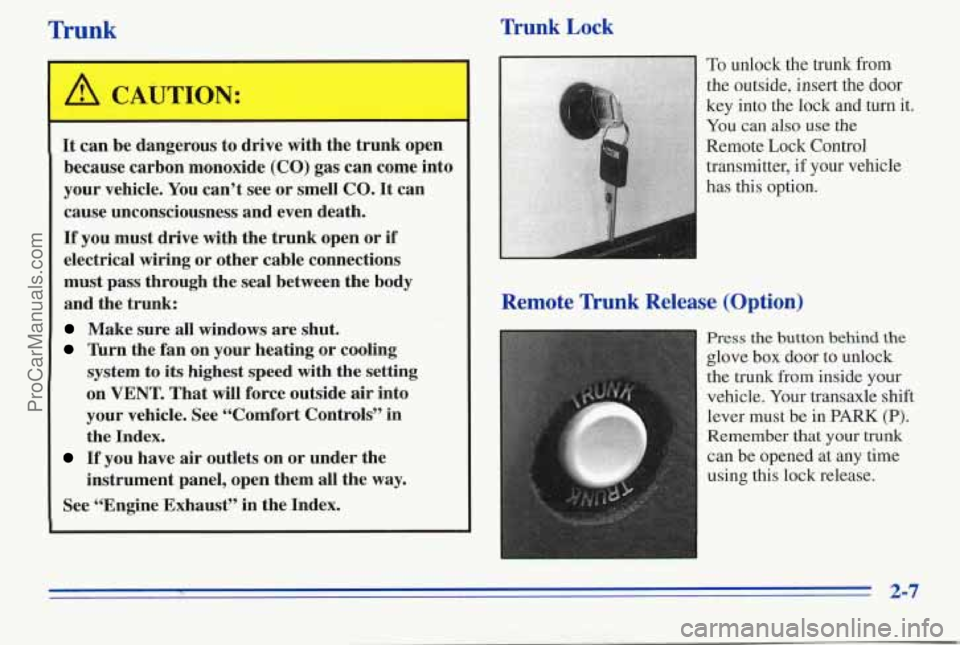
Trunk Trunk Lock
A CAUTION:
It can be dangerous to drive with the trunk open
because carbon monoxide (CO) gas can come into
your vehicle. You can’t see or smell CO.
It can
cause unconsciousness and even death.
If you must drive with the trunk open or if
electrical wiring or other cable connections
must pass through the seal between the body
and the trunk:
Make sure all windows are shut.
7hrn the fan on your heating or cooling
system to
its highest speed with the setting
on
VENT. That will force outside air into
your vehicle. See “Comfort Controls” in
the Index.
instrument panel, open them
all the way.
If you have air outlets on or under the
See “Engine Exhaust” in the Index.
To unlock the trunk from
the outside, insert the door
key into the lock and turn it.
You can also use the
Remote Lock Control
transmitter, if your vehicle
has this option.
Remote Trunk Release (Option)
Press the button behind the
glove box door to unlock
the trunk from inside your
vehicle.
Your transaxle shift
lever
must be in PARK (P).
Remember that your trunk
can be opened at any time
using this lock release.
2-7
ProCarManuals.com
Page 132 of 370
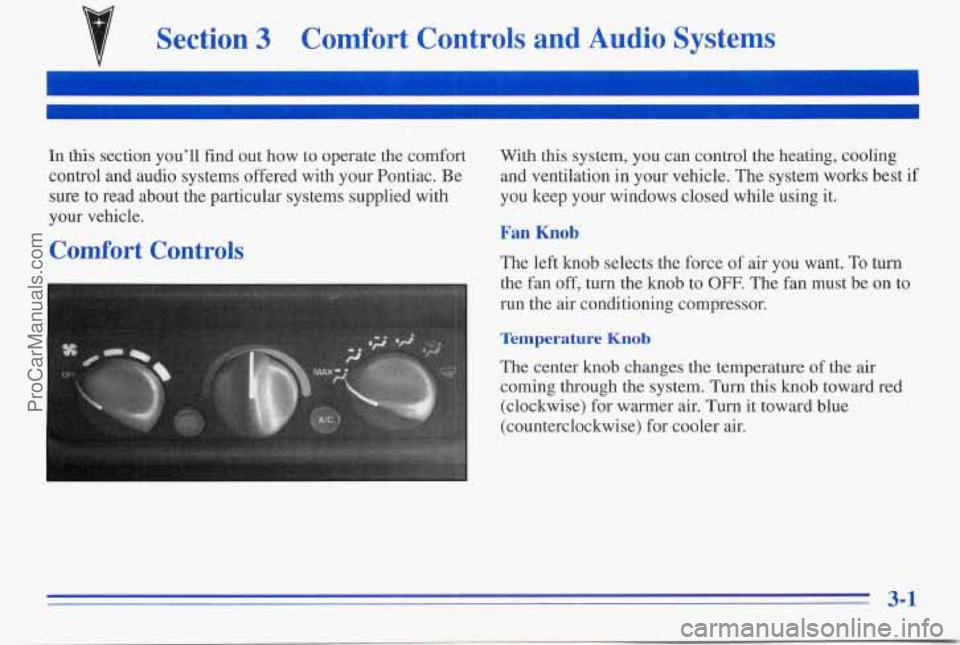
Section 3 Comfort Controls and Audio Systems
In this section you'll find out how to operate the comfort
control and audio systems offered with your Pontiac. Be
sure to read about the particular systems supplied with
your vehicle.
Comfort Controls
With this system, you can control the heating, cooling
and ventilation in your vehicle. The system works best if
you keep your windows closed while using it.
Fan Knob
The left knob selects the force of air you want. To turn
the fan
off, turn the knob to OFF. The fan must be on to
run the air conditioning compressor.
Temperature Knob
' The center knob changes the temperature of the air
coming through the system.
Turn this knob toward red
(clockwise) for warmer air. Turn it toward blue
(counterclockwise) for cooler air.
3-1
ProCarManuals.com
Page 133 of 370
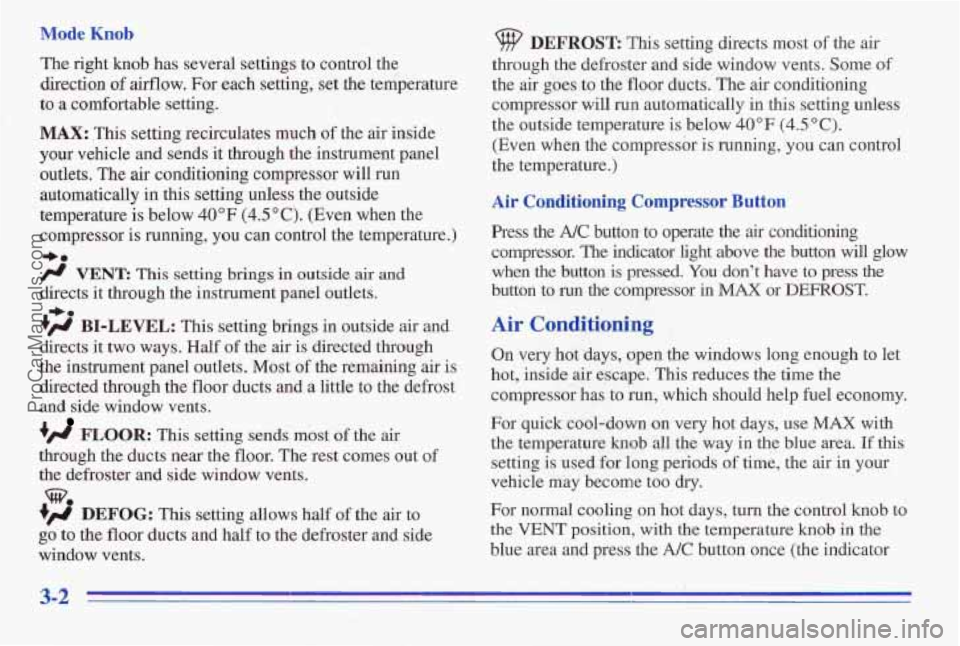
Mode Knob
The right knob has several settings to control the
direction of airflow. For each setting, set the temperature
to
a comfortable setting.
MAX: This setting recirculates much of the air inside
your vehicle
and sends it through the instrument panel
automatically
in this setting unless the outside
temperature is below
40°F (4.5"C). (Even when the
compressor
is running, you can control the temperature.)
+e
/J VENT This setting brings in outside air and
directs it through the instrument panel outlets.
+# BI-LEVEL: This setting brings in outside air and
directs
it two ways. Half of the air is directed through
the instrument panel outlets. Most
of the remaining air is
directed through the floor ducts and a little to the defrost
and side window vents.
?# FLOOR: This setting sends most of the air
through the ducts near the floor. The rest comes out of
the defroster. and side window vents.
sl3,
+# DEFOG: This setting allows half of the air to
go to the floor ducts and half to the defroster and side
window vents.
, outlets. The air conditioning compressor will run
+a
DEFROST: This setting directs most of the air
through the defroster and side window vents. Some of
the
air goes to the floor ducts, The air conditioning
compressor will run automatically in this setting unless
the outside temperature is below
40°F (4.5"C).
(Even when the compressor is running, you can control
the temperature.)
Air Conditioning Compressor Button
Press the A/C button to operate the air conditioning
compressor. The indicator light above the button will glow
when the button
is pressed. You don't have to press the
button to run the compressor in MAX or DEFROST.
Air Conditioning
On very hot-days, open the windows long enough to let
hot, inside air escape. This reduces the time
the
compressor has to run, which should help fuel economy.
For quick cool-down on very hot days, use MAX with
the temperature
knob all the way in the blue area. If this
setting is used for long periods of time, the
air in your
vehicle may become too
dry.
ror normal cooling on hot days, turn the control knob to
the
VENT position, with the temperature knob in the
blue area and press the A/C button once (the indicator
ProCarManuals.com
Page 134 of 370
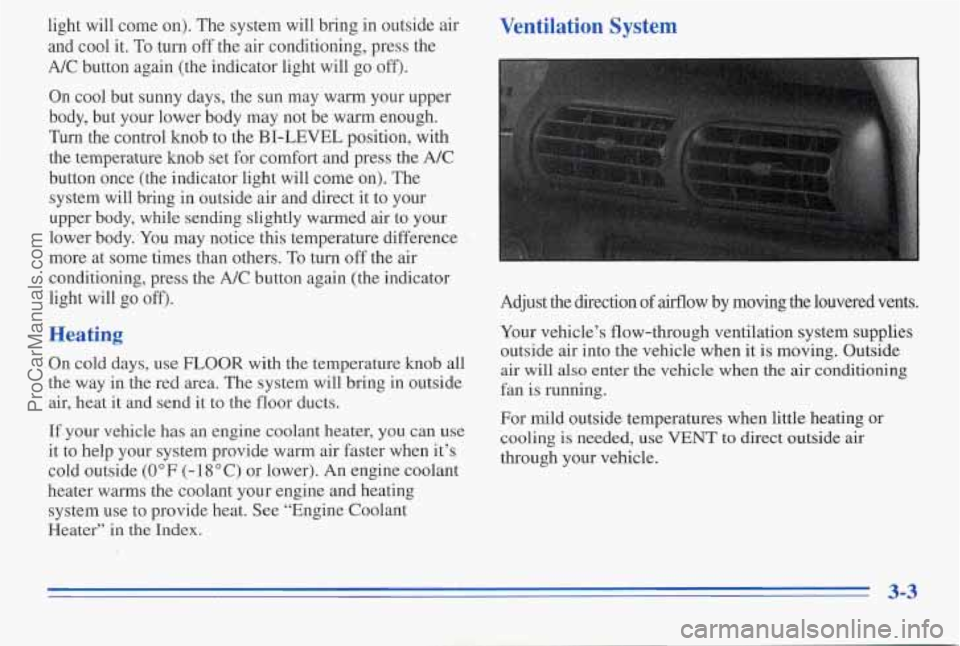
light will come on). The system will bring in outside air
and cool it. To turn off the air conditioning, press the
NC button again.(the indicator light will go off).
On cool but sunny days, the sun may warm your upper
body, but your lower body may not be warm enough.
Turn the control knob to the
BI-LEVEL position, with
the temperature knob set for comfort and press the
A/C
button once (the indicator light will come on). The
system will bring in outside air and direct it to your
upper body, while sending slightly warmed air to
your
lower body. You may notice this temperature difference
more at some times than others.
To turn off the air
conditioning, press the
A/C button again (the indicator
light will go
off).
Heating
On cold days, use FLOOR with the temperature knob all
the way in the red area. The system will bring in outside
air, heat it and send it to the floor ducts.
If your vehicle has an engine coolant heater, you can use
it to help your system provide warm air faster when it’s
cold outside
(0°F (-18°C) or lower). An engine coolant
heater warms the coolant your engine and heating
system use to provide heat. See “Engine Coolant
Heater” in
the Index.
Ventilation System
Adjust the direction of airflow by moving the louvered vents.
Your vehicle’s flow-through ventilation system supplies outside air into the vehicle when
it is moving. Outside
air will also enter the vehicle when the air conditioning
fan is running.
For mild outside temperatures when little heating or
cooling is needed,
use VENT to direct outside air
through your vehicle.
3-3
ProCarManuals.com
Page 178 of 370
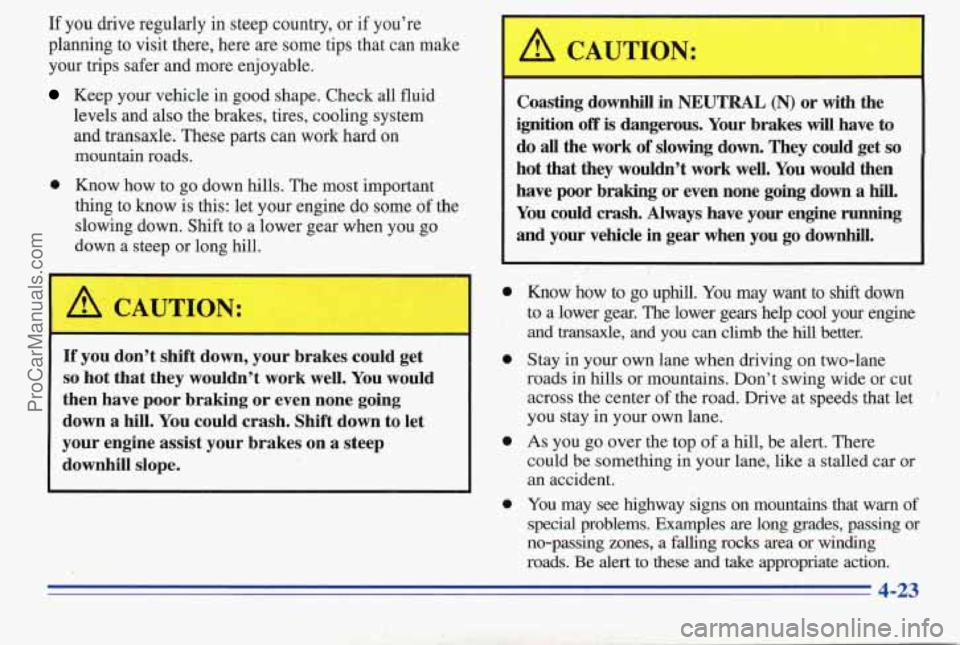
If you drive regularly in steep country, or if you’re
planning to visit there, here are some tips that can make
your trips safer and more enjoyable.
Keep your vehicle in good shape. Check all fluid
levels and also the brakes, tires, cooling system
and transaxle. These parts can work hard on
mountain roads.
0 Know how to go down hills. The most important
thing to
know is this: let your engine do some of the
slowing down. Shift to a lower gear when you go
down a steep or long hill.
L
If you don’t shift down, your brakes could get
so hot that they wouldn’t work well. You would
then have
poor braking or even none going
down a hill. You could crash. Shift down to let
your engine assist your brakes on
a steep
downhill
slope.
A CAUTION:
0
0
Coasting downhill in NEUTRAL (N) or with. the
ignition
off is dangerous. Your brakes will have to
do all the work of slowing down. They could get so
hot that they wouldn’t work well. You would then
have poor braking or even none going down a
hill.
You could crash. Always have your engine running
and your vehicle in gear when you go downhill.
Know how to go uphill. You may want to shift down
to a lower gear. The lower gears help cool your engine
and transaxle, and you can climb the hill better.
Stay in your own lane when driving on two-lane
roads in hills or mountains. Don’t swing wide or cut
across the center
of the road. Drive at speeds that let
you stay in your own lane.
As you go over the top of a hill, be alert. There
could be something in your lane, like a stalled car
or
an accident.
You may see highway signs on mountains that warn of
special problems. Examples
are long grades, passing or
no-passing zones, a falling rocks area or winding
roads.
Be alert to these and take appropriate action.
4-23
ProCarManuals.com
Page 192 of 370
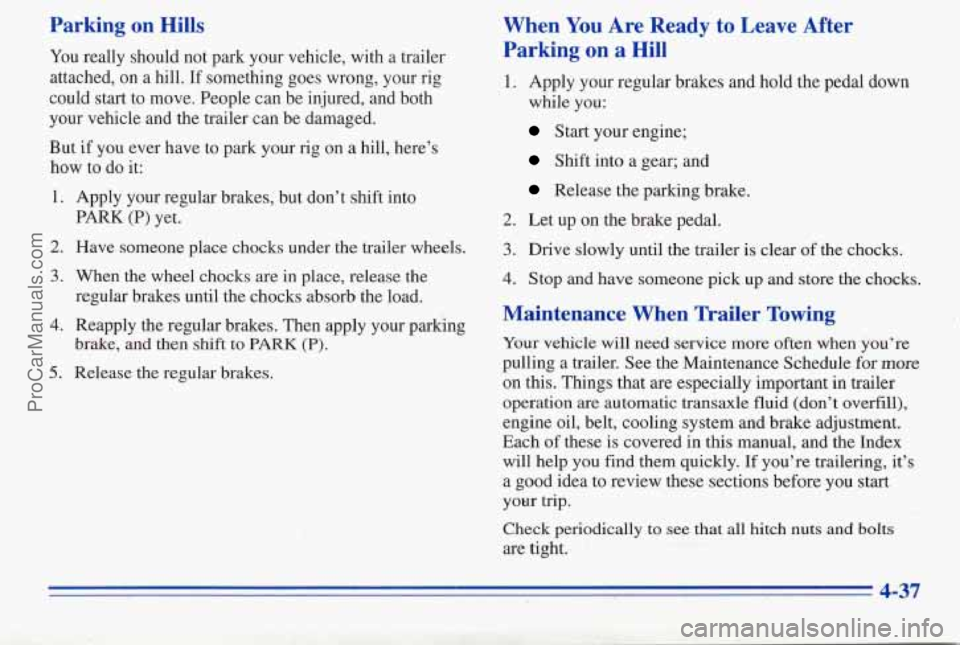
Parking on Hills
You really should not park your vehicle, with a trailer
attached, on
a hill. If something goes wrong, your rig
could
start to move. People can be injured, and both
your vehicle and the trailer can be damaged.
But if you ever have to park your rig on a hill, here’s
how to do it:
1.
2.
3.
4.
5.
Apply your regular brakes, but don’t shift into
PARK (P) yet.
Have someone place chocks under
the trailer wheels.
When the wheel chocks are in place, release the
regular brakes until the chocks absorb the load.
Reapply the regular brakes. Then apply your parking
brake,
and then shift to PARK (P).
Release the regular brakes.
When You Are Ready to Leave After
Parking on a Hill
1. Apply your regular brakes and hold the pedal down
while you:
Start your engine;
Shift into a gear; and
Release the parking brake.
2. Let up on the brake pedal.
3. Drive slowly until the trailer is clear of the chocks.
4. Stop and have someone pick up and store the chocks.
Maintenance When Trailer Towing
Your vehicle will need service more oken when you’re
pulling a trailer. See the Maintenance Schedule for -more
on this. Things that are especially important in trailer
operation
are automatic transaxle fluid (don’t overfill),
engine oil, belt, cooling system and brake adjustment.
Each
of these is covered in this manual, and the Index
will help you find them quickly. If you’re trailering, it’s
a good idea to review these sections before you start
your trip.
Check periodically to see that all hitch nuts and bolts
are tight. ’
4-37
ProCarManuals.com
Page 208 of 370
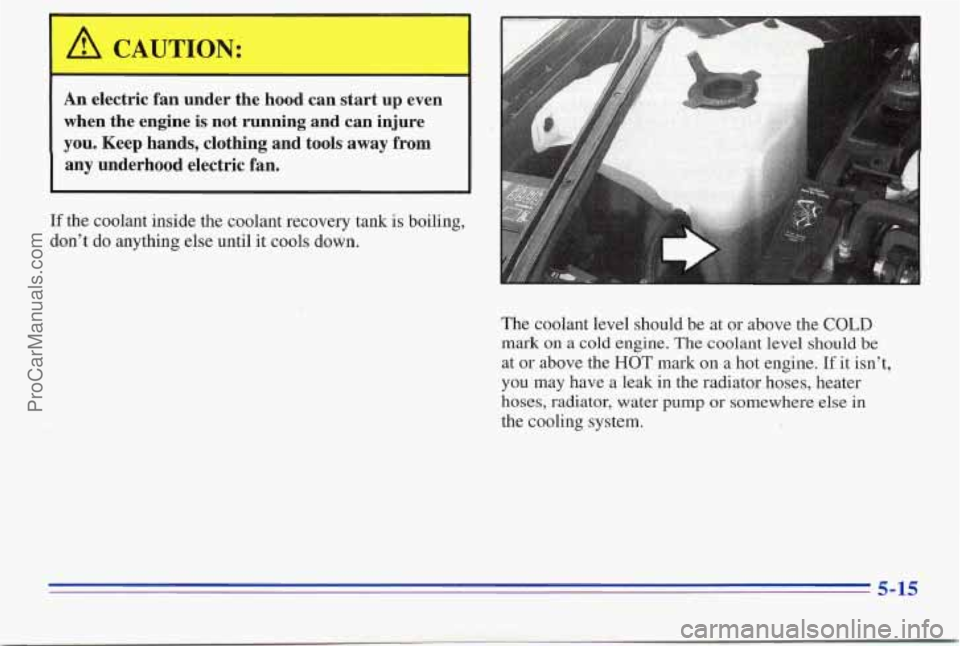
An electric fan under the hood can start up even
when
the engine is not running and can injure
you. Keep hands, clothing and tools away from
any underhood electric fan.
If the coolant inside the coolant recovery tank is boiling,
don’t do anything else until
it cools down.
The coolant level should be
at or above the COLD
mark on a cold engine. The coolant level should be
at or above the HOT mark on a hot engine. If it isn’t,
you may have a leak
in the radiator hoses, heater
hoses, radiator, water pump or somewhere else in
the cooling system.
5-15
ProCarManuals.com
Page 209 of 370
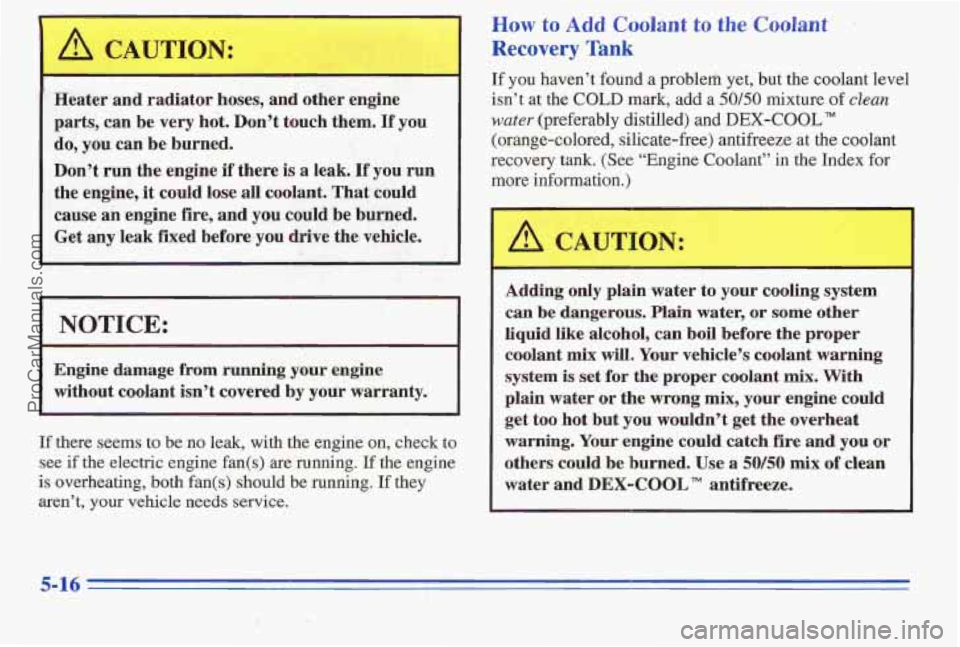
A CAUTION:
I
Heater and radiator hoses, and other engine
parts,
can be very hot. Don’t touch them. If you
do, you can
be burned.
Don’t run the engine
if there is a leak. If you run
the engine,
it could lose all coolant. That could
cause
an engine fie, and you could be burned.
Get
any ‘leak fixed before you drive the, vehicle.
I NOTICE:
I
Engine damage from running your engine
without coolant isn’t covered by your warranty.
I
If there seems to be no leak, with the engine on, check to
see if the electric engine fan@) are running. If the engine
is overheating, both fan(s) should be running. If they
aren’t, your vehicle needs service.
How to Add Coolant to the Coolant
Recovery Tank
If you haven’t found a problem yet, but the coolant level
isn’t at the COLD mark, add a 50/50 mixture of ckm
water (preferably distilled) and DEX-COOL”
(orange-colored, silicate-free) antifreeze at the coolant
recovery
tank. (See “Engine Coolant” in the Index for
more information.)
Adding only plain water to your cooling system
can be
dangerous. Plain water, or some other
liquid Eke alcohol, can boil before the proper
coolant
mix will. Your vehicle’s coolant warning
system
is set for the proper coolant mix. With
plain water or the wrong mix, your engine could
get too hot but you wouldn’t get the overheat
warning.
Your engine ‘could catch fire and you or
others could be burned. Use a
50/50 mix Q€ clean
water and
DEX-COOL antifreeze.
5-16
,LC !
ProCarManuals.com
Page 210 of 370
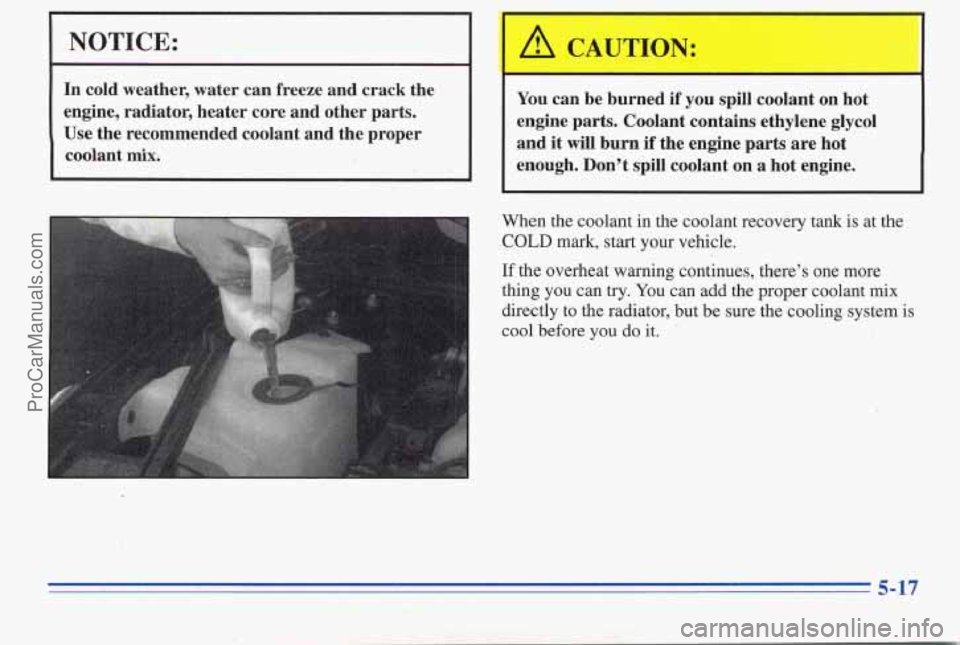
NOTICE:
In cold weather, water can freeze and crack the
engine, radiator, heater core and other parts.
Use the recommended coolant and the proper
coolant
mix.
You can be burned if you spill coolant on hot
engine parts. Coolant contains ethylene glycol
and
it will burn if the engine parts are hot
enough. Don't spill coolant on a hot engine.
When the coolant in the coolant recovery tank is at the
COLD mark, start your vehicle.
If the overheat warning continues, there's one more
thing you can
try. You can add the proper coolant mix
directly to the radiator,. but be sure the cooling system is
cool before
you do it.
5-17
ProCarManuals.com
Page 211 of 370

Steam and scalding liquids from a hot cooling
system can
blow out and burn you badly. Th'ey
are under pressure, and if
you turn the radiator
pressure cap
-- even a little I- they can come out
at high speed. Never turn the cap when the
cooling system, including the radiator pressure
cap,
is hot. Wait for the cooling system and '
radiator pressure cap to cool if you ever have to
turn the pressure cap.
ProCarManuals.com